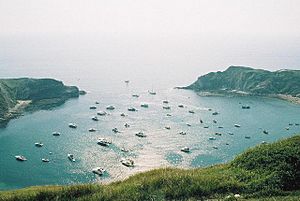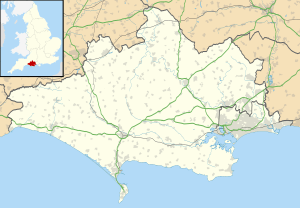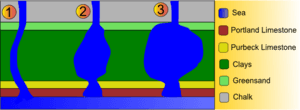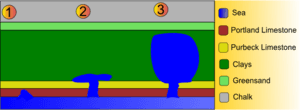Lulworth Cove facts for kids
Quick facts for kids Lulworth Cove |
|
|---|---|

Lulworth Cove from the north
|
|
| Location | Dorset, England |
| Coordinates | 50°37′06″N 2°14′49″W / 50.6183°N 2.2469°W |
Lulworth Cove is a beautiful, almost perfectly round bay on the Jurassic Coast in Dorset, southern England. It is near the small village of West Lulworth. This special place is known around the world for its unique shape.
Lulworth Cove is part of a World Heritage Site. This means it is very important for everyone to protect. Many people visit Lulworth Cove each year, about 500,000! Most visitors come in July and August. It is also close to other famous spots like the Durdle Door rock arch.
Contents
How Lulworth Cove Was Formed
Lulworth Cove formed because of different types of rock along the coast. These rock layers run parallel to the shoreline. Some rocks are hard, and some are soft.
The sea first broke through the hard outer layers of rock. These layers were made of Portland limestone and Purbeck limestone. The Portland limestone forms a narrow band less than 30 meters (about 100 feet) wide. Behind it is the Purbeck limestone, which is a bit softer.
Once the sea got past these hard layers, it reached much softer rocks. These softer rocks include clays and greensands. The sea could easily wash away these soft rocks. This created the wide, round shape of the cove.
At the very back of the cove is a band of chalk. Chalk is harder than the clays and sands. But it is not as hard as the limestones. This chalk layer stops the cove from getting even bigger. The narrow entrance to the cove is where the waves first broke through the hard limestone.
Stair Hole: A Baby Cove
If you walk a short distance west from Lulworth Cove, you will find Stair Hole. Stair Hole is like a "baby" version of Lulworth Cove. It shows how Lulworth Cove might have looked many thousands of years ago.
At Stair Hole, the sea has just started to break through the hard limestone layers. It has made a small gap and a tiny arch. The waves are now starting to erode the softer clays behind the limestone. Over a very long time, Stair Hole might grow into a larger cove, just like Lulworth.
The Geography of the Cove
The unique shape of Lulworth Cove affects how waves behave. When waves enter the narrow opening, they bend and spread out. This is called diffraction. It makes the waves form an arc shape inside the cove. You can see this arc shape in the photo below.
Protecting Lulworth Cove
Lulworth Cove is part of a very special area. Nearby, you can find Durdle Door, a famous natural rock arch. There is also a fossilized forest to the east. The area is also close to Kimmeridge, which is known for its rocky shore and many fossils.
Scientists have been interested in this area for a long time. They have studied its geology since the early 1800s. Students from all over the world come here to learn about rocks and landforms.
Because so many people visit, the area can get damaged. Walking paths can become worn down. To help protect the land, wooden steps, fences, and special paths have been built. These help guide visitors and reduce damage to the ground.
In 2001, the entire Jurassic Coast was named a World Heritage Site by UNESCO. Experts are working to keep Lulworth Cove and its surroundings safe and beautiful for the future.
Most of the land around Lulworth Cove is owned by the Lulworth Estate. This estate belongs to the Weld family. They help manage and protect the area. There is also a Heritage Centre nearby. It acts as a visitor center and a natural history museum. Many people visit it to learn more about the cove.
Some land to the east is used by the Ministry of Defence for tank training. This part is only open to the public on weekends and holidays.
Interesting Facts
Lulworth Cove is so unique that a bay on Titan, Saturn's largest moon, is named after it! This bay is called Lulworth Sinus and is part of a large hydrocarbon sea called Kraken Mare.
See also
 In Spanish: Lulworth Cove para niños
In Spanish: Lulworth Cove para niños





